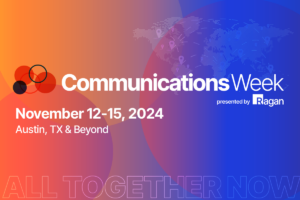Reduce, reuse, recycle: Setting reasonable expectations when comms is asked to do everything
Communications Week board members share how they are leading the way by aligning on deliverable goals.

Internal communications leaders often share the same operational grievance — because they work so well across functions, even when they are such good collaborators and relationship builders, it feels as though endless requests keep coming.
It’s easy enough to maintain an editorial calendar or use project management software, but creating and protecting an artful, strategic cadence becomes harder when things come down from on high, from across the room, or from partners that comms has no visibility around.
How can communicators safeguard their workflows and refine the art of saying “not right now, here’s why?” We spoke to two Ragan Communications Week board members to learn how they realign expectations to stay strategically focused while remaining helpful cross-functional partners.
Aligning goals from the get-go
When asked to create something seemingly ad hoc, the best place to start is by asking questions about goals.
“Sometimes, because we’re all so busy, we don’t ask ‘why’,” said FREYR Battery SVP of U.S. Communications Amy Jaick.
“You know, ‘Tell me more about what you’re trying to achieve’. Because sometimes what people are asking for is not the only solution. And sometimes I’m able to find efficiencies or synergies in that way.”
Jaick supposes there may be a time when someone comes to you and asks you to write a press release, which you could engage by prompting a deeper conversation about who they are trying to reach.
“’Is it broadly appealing, are you trying to reach the masses or is this better as a very targeted social post?’” Jaick might ask. “’Can we make this an internal announcement, take some of the language from that and social post very targeted, you know, or can we make this an internal announcement and then we take some of the language from that and share it in a different way?’”
“Part of the solution is understanding what people are trying to achieve from the get-go, not just what they‘re asking,” added Jaick. “And once you have an understanding of that, do you need to create this?”
Moving away from single-use comms
Jaick’s question as to whether something must be created net new each time or whether it’s better to work with something you already have, then reshape or reform it, is a matter of each time and energy investment.
Danielle Brigida, sr. communications director at The World Wildlife Fund (WWF), believes that we shouldn’t be creating very many one-off pieces of communication as a rule.
“You just don’t have time to do something that you can only use for one purpose,” Brigida said. “Single-use content is like single-use plastic. You should avoid it whenever possible. “
“We’re rewarded as communicators for outputs,” she continued. “Especially the cheap outputs, the things you don’t have to work as hard on but get you a lot of exciting feedback. It’s about balancing that with strategy… like skiing downhill and taking the paths that already exist versus the ones you have to carve out on your own.”
So how do you make sure the proactive paths you carve out on your own aren’t one-and-done?
Brigida recently reframed a request for a video promoting an upcoming conference from being strictly focused on the conference to instead covering the bigger question of why, in this case, tigers are important to biodiversity and how they benefit people, too. WWF will be able to continue using this content well after the conference, but it can still be helpful with conference promotion. At the end of the day, creating helpful content that serves multiple purposes is one way to benefit many areas of work. It’s an extra step to think through your communications this way, but it’s well worth it.
“When we’re resource-constrained, we’ve got to figure out how to repurpose as much as possible,” she added with a wink and a nod to a classic sustainability slogan. “I think ‘reduce, reuse, recycle’ is a good comms strategy.”
Embracing a tiered structure of support
When one is overwhelmed, it’s easy to get defensive and say ‘no’ to new requests. While this tendency is natural, learning to say, ‘yes, but’ is the more diplomatic approach.
Jaick understands how communicators can tier the systems of support that they provide. Using a premise wherein another function needs social media support and your team is overwhelmed, Jaick saw three scenarios.
In one, her team helps them directly craft those posts and they work on it together.
The second is when her team gives them quality examples for similar situations, “where we’ve seen this happen enough times that I can kind of give you a structure that you can take and make your own,” explained Jaick. “It’s sort of prefabbed—it’s not custom, but there’s enough there that you can take from it and create your own.”
In a third scenario, you simply provide a couple of examples of teams who have done it well.
“It’s ‘yes, and’ or ‘yes, but’ where you’re not saying no entirely,” Jaick said. “’Yes, I can help you and this might be a good way’ or ‘Yes, I can help you but we’re not able to devote all this time to a campaign — here’s a framework.’”
How are you repurposing content and level-setting around asks by tying them back to goals? Let us know, and don’t forget to join us in Austin for Ragan’s Communications Week and the Future of Communications Conference.







